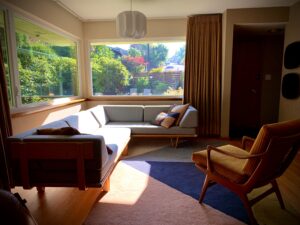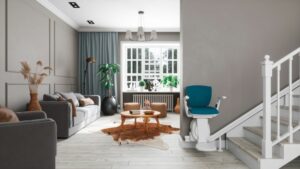By Kat Gilpatrick, January 18, 2024
Aging in place.
It sounds like poetry, and feels even softer. a familiar and more attractive alternative to uprooting or living somewhere unfamiliar. To find or create a house that would enable accessible living.
There are a number of options outside of aging in place: A well-suited senior living facility, one of the many 55+ communities, co-ops, etc. — but if staying in a your home, or choosing a home whose floorpan and configuration would transition in the longer term are for you, then read on.
It’s a topic that’s on the minds of many. As we inch toward 60, as our kids move out of the house, or our landscapes change, we can’t help but do. It’s a conversation I am part of all the time. “Let’s look for something we can have as our forever home” “We’d like something one level” “We’re looking for something to share with our parents”
We look at where will we go? Move closer to family? A community? What kind of life do we want? What is important to us? What does home mean, and what are our physical limitations?
Thinking about all of this; planning for it, and taking action on to make this lifestyle decision as we grow older is worth taking the time to understand deeply.
So many of us would like to stay in our own homes, to maintain independence for as long as possible; turning to family and friends for help only when needed, living independently and comfortably for as many years to come as possible. Of course there are concerns about safety; the ease and ability to get around, and perform daily activities. Living at home as you age requires careful consideration of timing and costs and planning (and hiring!) for the project.

Two main places to start are understanding the below:
Timing
Aging-in-place remodeling is how older individuals who want to live out their years in their beloved homes can forego the significant expenses of a retirement home or assisted living facility. The best time to make the appropriate renovations and adapt your home for future needs is before your health requires it.
What’s needed. Here’s a pretty comprehensive list to consider when ensuring the home can transition with you:
One Level Living
Updates to the home so that all living areas are on the main level is key. Climbing stairs several times daily can be physically painful and pose a fall risk.
If there are levels to consider, sturdy handrails are a must, or even adding a chair lift from one level to another.

Safe Floors
Keeping clutter off floors reduces the risk of tripping and falling. And the type of flooring you have in your home will also affect your chances of taking a fall. If you are using carpeting, the pile shouldn’t be more than a half inch, with a nonslip flooring material underneath, such as rubber, cork, or vinyl.
Increase Widths
Layout with a sunken living room, or a high threshold while moving from room to room are other mobility concerns. Installing a ramp over small thresholds can help make it easier to get around.
The Kitchen
Several changes can make the kitchen safer and more enjoyable for older adults.
- Lower parts of the counters for accessibility, and consider adding pullout shelving, especially in lower cabinets.
- Revamp the basic layout of the kitchen for comfort and safety.
Install Bathroom Enhancements
Basic bathroom modifications when planning aging-in-place renovations:
- Walk-in showers: without a typical shower threshold, allow wheelchair access if needed.
- Switch out a traditional tub with a walk-in tub. Be sure to install grab bars, and be sure they are held steady by being embedded into wall studs. With modified showers of any kind, add a shower seat and handheld shower head to prevent falls.
- Toilet—add a riser seat
And other home modifications to consider incrementally:
- Installing a shower bar
- Get a non-slip bedside mat and a low-profile bed
- Removing throw and area rugs throughout the house
- Adding handrails in high-slip locations
- Putting in doorway ramps
- Installing an emergency call alert system
- Getting an automatic toilet flushing system
- Invest in open shelves or cabinetry in all rooms you use
- Add anti-scalding temperature controls on all the faucets
- Adding a doorbell or an entire smart home security system that allows you to see who is at the door without walking directly to it is also a significant safety feature.
- Another feature is motion-sensitive lighting at the home’s entrance and any back entrance.
